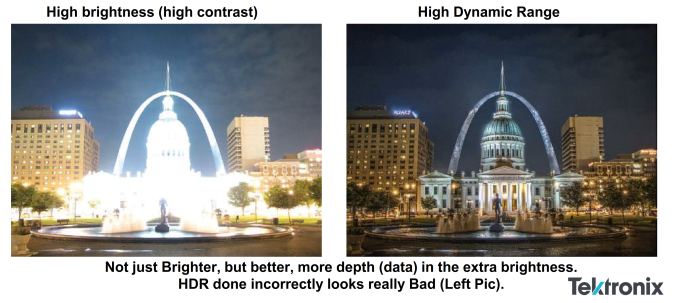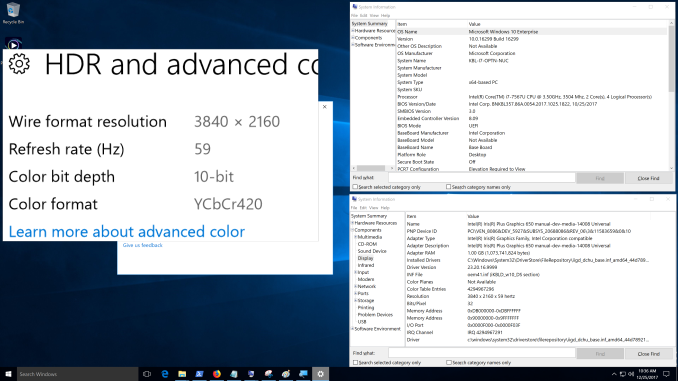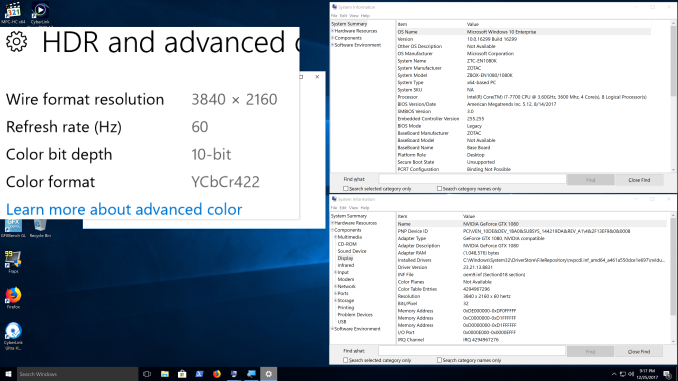A Budget Home Theater & PC Setup: 4K, HDR, UHD Blu-ray, and More
by Ganesh T S on December 26, 2017 8:30 AM ESTHDR Support
High Dynamic Range (HDR) is one of the most impressive features in the recent crop of 4K televisions. In layman's terms, it refers to the ability of a single frame to have wide variation in brightness for different regions. This allows the details in the dimly lit areas of the frame to be seen more clearly. Overall, it delivers a more vivid picture to the viewer. Note that this is quite different from the concept of high contrast.
Picture courtesy: SMPTE HDR Presentation from Steven Holmes of Tektronix
The ability of a display source to transmit HDR frames, as well as that of a display sink to be able to accept and understand them, can be gathered from the HDMI port's specifications. However, being able to accept and understand is only part of the problem. There are many low-cost 'fake HDR' TVs that simply parse the HDR information, but, do not have the ability to translate that to the display.
There are many HDR 'standards', with the base requirement being HDR10. Shifting a display sink into HDR mode involves the source sending some information (metadata) with the characteristics of the video being transported (the mapping of the pixel data to the displayed luminance, light levels in the video stream etc.). If this is static (i.e, done once when the shift to HDR mode occurs), it falls under the HDR10 category. Dolby Vision allows for the metadata to change on a frame-by-frame basis (dynamic). The upcoming HDR10+ standard will also support dynamic metadata. The takeaway is that Dolby Vision certification all but ensures a display with true HDR capabilities.
The TCL 55P607 comes with standard HDR10 and Dolby Vision support. The native Roku apps shift to the appropriate HDR mode based on the content being played back. We will analyze this more in the subsequent sections.
The NVIDIA SHIELD Android TV (SATV) is similar to the native Roku app in the TV with respect to treatment of HDR content. The main issue is that SATV doesn't support Dolby Vision yet, though there is a lot of clamor for it from SATV owners. Videos with HDR10 metadata shift the display to the appropriate HDR mode prior to playback.
PCs encounter additional challenges for HDR implementation. It is just not one company that is responsible for the feature. On one hand, the GPU driver vendors need to support it. On the other hand, the OS itself needs to provide hooks to enable HDR. Finally, the software ecosystem needs to catch up. The Windows 10 Fall Creators Update brought HDR10 capabilities for the Windows desktop into the stable ring. It also allowed streaming of HDR videos from YouTube and Netflix. Microsoft is continuing to fine-tune the HDR capabilities built into Windows 10.
Intel, along with CyberLink, had decided not to wait for Microsoft to deliver HDR on PCs. PowerDVD 17 was the first software Blu-ray player, and it only made sense for them to support HDR playback for applicable titles. The Intel / CyberLink solution for HDR when playing back certain Blu-rays in full-screen exclusive mode is orthogonal to Microsoft's HDR support.
The Windows 10 Fall Creators Update enabled desktop HDR and HDR video streaming on all the three test PCs described earlier.
HDR and Advanced Color Settings - Intel NUC7i7BNHX1 with Desktop HDR Enabled
The KBL-U platforms drove the display at YCbCr 4:2:0 10-bit, while the NVIDIA GTX 1080 drove the HDR output with higher quality (YCbCr 4:2:2 10-bit). For a good desktop experience, 4:4:4 is preferable.
HDR and Advanced Color Settings - Zotac ZBOX MAGNUS EN1080K with Desktop HDR Enabled
Gaming is not a focus in our HTPC reviews, but, we must give credit to NVIDIA for supporting Dolby Vision in their Pascal GPUs. Certain gaming titles such as Battlefield 1 support both HDR varieties (HDR10 and Dolby Vision), and the Zotac EN1080K is able to deliver it in a HTPC environment, thanks to its small form factor and relatively silent liquid cooling.
Battlefield 1 HDR Output from the Zotac EN1080K
Battlefield 1 Dolby Vision Output from the Zotac EN1080K
Unfortunately, Pascal's Dolby Vision support is available only in certain games, and is not applicable to streaming services like Netflix.
Microsoft's current approach to HDR with a desktop HDR mode is currently not efficiently implemented. For example, the desktop in the Zotac ZBOX MAGNUS EN1080K idles at 34.5W. With the HDR mode enabled, this jumps to 39.5W. In the KBL-U systems the penalty is of the order of 0.8W - 1W.















191 Comments
View All Comments
Reflex - Thursday, December 28, 2017 - link
Again, you made the claim he gave a "$2000 HTPC reccomendation" as part of the article. He did not. He merely listed it as an option for those focused on gaming. You lied. You can spew all sorts of crap into as many paragraphs as you wish, but you have no credibility when you willfully lie about the contents of articles simply to 'prove' whatever point you somehow think you are proving.As to the rest, spend some time on AVSForums and you'll learn what is budget, midrange and high end for a 'home theater', rather than what you think you can cobble together with your home CNC setup and 'custom networking protocols'.
You are the biggest joke on this site since Steve Lake/Lord Raiden.
ddrіver - Thursday, December 28, 2017 - link
Guess they're not important enough to show up when you look for "budget receiver" on Google huh? Stop trying to cover up the mess. There are options between $100 and $1million. But almost every normal person will agree that $1000 is not "budget". That's why every article and review out there confirms what I'm saying: $300-$500 is what most regular people call "budget".But just to show you how unbelievably dumb you are I actually searched AVS Forum for "budget receiver". Guess what was the most commonly recommended price range... You probably guessed wrong. It's between $300-$500, with very, very, VERY few exceptions at $600-$700.
Like this: http://www.avsforum.com/forum/gtsearch.php?q=budge...
Or this: http://www.avsforum.com/?s=budget%20receiver
Come on, keep making that point =)). I'm sure you can make a bigger ass of yourself.
ddrіver - Thursday, December 28, 2017 - link
BTW, you're so focused on insulting me and proving I'm wrong that you don't even realize your own arguments contradict your case. That's just pathetic. You're willing to make a fool of yourself and ignore all common sense and evidence in your attempts to just contradict me.A $1000 receiver isn't budget. It just isn't. Budget is another word for cheap but still reasonably OK. And I was actually looking for a good recommendation for a home theater setup, at least the receiver and speakers part. I expected some info about a budget setup. $1000 just for the receiver? Yeah, he mentions another cheaper (~$500) receiver but that doesn't help sine I basically have to read the details elsewhere. So how is that an article about a budget setup again?
Bullwinkle-J-Moose - Thursday, December 28, 2017 - link
ddriver, For BUDGET Home Theater......Check the comparisons and reviews of PreSonus Eris Powered 5 and 8" Monitors to the JBL LSR305 and 308 on Youtube (I chose the JBL)
(Room size will determine which one you need)
2nd place>
KRK are too colored and boomy for me and Yamahas HS5 and HS8 are considerably more expensive for 2nd place sound
3rd place> There is no 3rd place!
---------------------------------------------
I also noticed you mentioned > "A receiver is an integral part of a home theater."
WHY?
For those who make the computer their central repository of all things Media to keep their setup "Minimal", I would think that a receiver would only have value for those who value DRM Lockdown and clutter
Reflex - Thursday, December 28, 2017 - link
1) I don't have to prove you wrong, you do that effectively on your own.2) The article also listed a receiver in the price range you suggest is budget as well. You seem unwilling to acknowledge that fact. Weirdly enough, you give more attention to the very brief mention of a gaming HTPC (on a primarily PC based site no less!) than the fact that they actively discussed the even cheaper option in the article itself and in the final table. Seriously, selection bias much?
And yes, I never claimed there was no such thing as a receiver for less than $1k. However even at $1k, its a budget receiver. It is in no way out of scope for an article like this. $1k is below what is considered mid-range in this space for actual 'home theaters' rather than "TV and receiver in the living room" class setups.
Bullwinkle-J-Moose - Thursday, December 28, 2017 - link
Reflex says....(on a primarily PC based site no less!)
---------------------------------------------------
Sorry Reflex but this is clearly not a PC based site!
A "Personal" Computer would let "you" control every aspect of your own system
This site is based around Locked Down DRM Spyware Platforms that prevent the end users from securing their own systems
DRM destroys the National Security of All Countries by keeping those back doors open
Try using the Internet without letting Microsoft continually make changes to "your" computer or monitoring everything you do while using Spyware Platform 10
Whenever you must rely on strangers to provide YOUR security, you have no security
The PC died with Sandy Bridge
Reflex - Friday, December 29, 2017 - link
You are welcome to your opinion, but others are not required to subscribe to it.Bullwinkle-J-Moose - Friday, December 29, 2017 - link
"You are welcome to your opinion, but others are not required to subscribe to it."---------------------------------------------------------------------------------------------------------
As are you
When you say "Real Home Theater"
How does that differ from "ANY" Home Theater
Must we conform to 1000 different "Standards" to make it "Real" ?
Must it have the latest DRM Lockdown ?
What "EXACTLY" makes your Home Theater "Real" and mine "not so much" ?
We would like to hear your expert opinion on the matter before we destroy it
Reflex - Friday, December 29, 2017 - link
I usually refer to what people consider the definition on home theater focused websites and forums. Obviously you are free to define home theater however you like.Most people who build a home theater these days want at least Dolby 5.1/7.1 with many opting for the better positional audio of Dolby Atmos. Most people who build a home theater these days want 4k resolution with at least HDR10 with some opting for the slightly superior Dolby Vision standard.
If your goals are to display content optimally, and playback audio optimally, equipment choices are dictated by those factors within the budget you have permitted yourself. All the rest is just noise. I don't give a damn if my content is DRM'd so long as the equipment I select can play it back reliably. I'm not even sure what 'DRM Lockdown" means in this context if everything I set up to play back the content can play it. I don't really care about hypotheticals or other scenarios that I am not interested in, nor are most people in this space given that as you point out those standards generally win out in the market.
As for the value judgement, I've made zero comments about your home theater and its 'realness'. If you consider it real, more power to you. But again, I don't have to subscribe to your interpretations, recommendations or priorities when discussing or making recommendations on this area myself. As with most people, I go with what the prevailing standards are and it is reasonable to judge articles, content and conversations based on that understanding. If everyone builds their own definition of a term and insists others cater to only their definition we lose the ability to discuss any topic rationally.
Bullwinkle-J-Moose - Friday, December 29, 2017 - link
"I usually refer to what people consider the definition on home theater focused websites and forums. Obviously you are free to define home theater however you like."-------------------------------------------------------------------------------------
That's a valid point
After defining and building the modern 3-Channel System upon which all these current standards are based (3.1 / 5.1 / 7.1 etc), it's nice to know I can have my own opinion on the matter
The only standard now is that there is no standard!